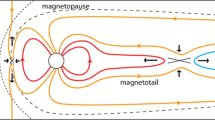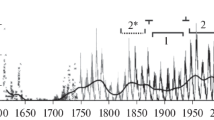Abstract
All significant short-term disturbances of the near-Earth space are caused exclusively by solar flare events and regions in the solar corona with the magnetic field open into the interplanetary space (coronal holes). Flare processes occur as a consequence of the interactions of new emerging magnetic fluxes within (flares) and outside (filament ejections) the active regions with already existing magnetic fields. The observation of emerging new magnetic fluxes and the estimate of their magnitude and the emerging rate allow one to forecast solar flares and filament ejections and estimate their degree of geoeffectiveness. The main agents that visualize the propagation of disturbance from solar flares and filaments in the solar corona and the interplanetary space are coronal mass ejections, the characteristics of which ideally allow one to estimate the possible disturbance of the geomagnetic field, the possible growth of high-energy charged particle fluxes in the near-Earth space. For successful forecast of geoeffective active phenomena on the Sun and their consequences in the near-Earth space, it is necessary to know the situation on the Sun for the last 3 days taking into account the development and characteristics of the current cycle and the epoch of solar activity.
Similar content being viewed by others
References
Ishkov, V.N. and Shibaev, I.G., Solar activity cycles: general characteristics and modern forecasting boundaries, Bull. Russ. Acad. Sci., Phys., 2006, vol. 70, no. 10, pp. 1643–1647.
Shibaev, I. and Ishkov, V., Investigation of the statistical characteristics of Wolf numbers reliable series: Signs of solar cycles likelihood, in The 7th Scientific Conference “Space, Ecology, and Safety” (SES-2011), Sofia, 2012, p. 297.
Ishkov, V.N., Periods of “lowered” and “increased” solar activity: Observant special features and key facts, in Solnechnaya and solnechno–zemnaya fizika-2013 (Solar and Sun–Earth Physics-2013), Nagovitsyn, Yu.A., Ed., St. Petersburg, 2013, p. 111. http://www.gao.spb.ru/ russian/publ-s/conf_2013/conf_2013.pdf.
Ishkov, V.N., Characteristics of solar activity in the long phase of minimum of solar cycles 23 and 24, in Tsikly aktivnosti na Solntse i na zvezdakh (Cycles of Activity on the Sun and Starts), Obridko, V.N. and Nagovitsin, Yu.A., Eds., St. Petersburg, VVM, 2009, p. 57.
Ishkov, V.N., Emerging magnetic fluxes: A key to forecasting large solar flares, Izv. Ross. Akad. Nauk, Ser. Fiz., 1998, vol. 62, pp. 1835–1839.
Golovko, A.A., The regions of new magnetic flux with fast evolution. 1. The “magnetic flux–evolution time” diagram, Soln. Dannye, 1986, no. 5, pp. 48–53.
Golovko, A.A., Relationship between the maximum magnetic fluxes and lifetimes of solar active regions, Astron. Rep., 1998, vol. 42, no. 4, pp. 546–552.
Obashev, S.O., Minasyants, G.S., and Makarenko, N.K., The structure of time series of formed by flares in separate sunspot groups, in Solnechnaya aktivnost (Solar Activity), Omarov, T.B, Ed., Alma-Ata: Nauka, 1973, p. 103.
Choi, Y., Moon, Y.-J., Choi, S., et al., Statistical analysis of the relationships among coronal holes, corotating interaction regions, and geomagnetic storms, Sol. Phys., 2009, vol. 254, no. 2, pp. 311–323. doi 10.1007/ s11207-008-9296-3
Joselyn, J.A., SESC methods for short-term geomagnetic prediction, in Solar Terrestrial Predictions: Proceedings of a Workshop at Meudon, France, June 18–22, 1984, Boulder, Colorado, NOAA, 1984, p. 404.
McAlister, A.H., Dryer, M., Mcintosh, P., et al., A quiet CME and a severe geomagnetic storm: April 14–17, 1994, Proceedings of the Second SOLTIP Symposium, Watanabe, T., Ed., 1994, vol. 5, p. 191.
Mayaud, P.N., Analysis of storm sudden commencements for the years 1868–1967, J. Geophys. Res., 1975, vol. 80, no. 2, pp. 111–122.
Ishkov, V.N., Emerging magnetic fluxes and flare phenomena on the Sun, Cand. Sci. (Phys.–Math.) Dissertation, Troitsk, Moscow: N.V. Pushkov Institute of Terrestrial Magnetism, Ionosphere, and Radiowave Propagation, RAS, 2008 [in Russian].
Author information
Authors and Affiliations
Corresponding author
Additional information
Original Russian Text © V.N. Ishkov, 2017, published in Kosmicheskie Issledovaniya, 2017, Vol. 55, No. 6, pp. 391–398.
Rights and permissions
About this article
Cite this article
Ishkov, V.N. Space weather forecast: Principles of the construction and boundaries of the implementation (experience of three cycles). Cosmic Res 55, 381–388 (2017). https://doi.org/10.1134/S0010952517060053
Received:
Published:
Issue Date:
DOI: https://doi.org/10.1134/S0010952517060053




